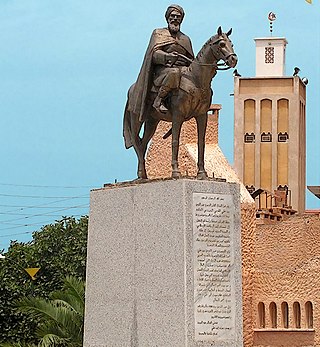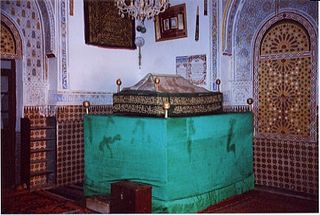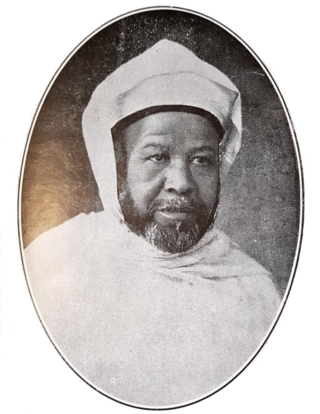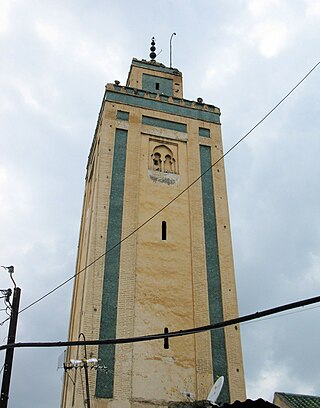Related Research Articles

Abd al-Hafid of Morocco or Moulay Abdelhafid was the Sultan of Morocco from 1908 to 1912 and a member of the Alaouite Dynasty. His younger brother, Abdelaziz of Morocco, preceded him. While Mulai Abdelhafid initially opposed his brother for giving some concessions to foreign powers, he himself became increasingly backed by the French and finally signed the protectorate treaty giving de facto control of the country to France.

Abd al Mu'min was a prominent member of the Almohad movement. Although the Almohad movement itself was founded by Ibn Tumart, Abd al-Mu’min was the founder of the ruling dynasty and creator of the Almohad empire. As a leader of the Almohad movement he became the first Caliph of the Almohad Empire in 1133, after the death in 1130 of the movement's founder, Ibn Tumart, and ruled until his death in 1163. Abd al-Mu'min put his predecessor's doctrine of Almohadism into practice, defeated the Almoravids in present-day Morocco, and extended his rule across Al-Andalus and as far as Tunis in Ifriqiya, thus bringing the Maghreb in North Africa and Al-Andalus in Europe under one creed and one government.

Abū Yūsuf Yaʿqūb ibn Yūsuf ibn Abd al-Muʾmin al-Manṣūr, commonly known as Yaqub al-Mansur or Moulay Yacoub, was the third Almohad Caliph. Succeeding his father, al-Mansur reigned from 1184 to 1199. His reign was distinguished by the flourishing of trade, architecture, philosophy and the sciences, as well as by victorious military campaigns in which he was successful in repelling the tide of the Reconquista in the Iberian Peninsula.
The Banu Tujib, the Tujibids or Banu al-Muhajir, were an Arab dynasty on the Upper March of Al-Andalus active from the ninth to the eleventh centuries. They were given control of Zaragoza and Calatayud by the Umayyads as a counterweight to the independence-minded Muwallad nobility of the region. In Zaragoza, they developed a degree of autonomy that served as the precursor to their establishment of an independent Taifa of Zaragoza after the collapse of the Caliphate of Córdoba. They ruled this taifa from 1018 until they were expelled by another Arab dynasty, the Banu Hud, in 1039. An exiled junior line of the family, known as the Banu Sumadih, established themselves as rulers of the Taifa of Almería, which they held for three generations, until 1090.

Aḥmad ibn Muḥammad ibn ʿAjība al-Ḥasanī was an influential 18th-century Moroccan scholar and poet in the Sunni Darqawa Sufi lineage.
Shihab al-Din abu l-‘Abbas Ahmad ibn Mohammed ibn Mohammed ibn Ahmed ibn Ali ibn 'Abd ar-Rahman ibn Abi'l-'Afiyya al-Miknasi az-Zanati, known simply as Ahmad ibn al-Qadi or Ibn al-Qadi (1552/1553–1616), was a Moroccan polygraph. He was the leading writer from Ahmad al-Mansur's court in Morocco next to Abd al-Aziz al-Fishtali. He was also a renowned judge and mathematician.

Abu Muhammad Salih ibn Yansaran Said ibn Ghafiyyan ibn al-Haj Yahya al-Dukkali al-Majiri, simply known as Abu Muhammad Salih (1155–1234), was a Moroccan saint and one of the successors of Abu Madyan. He was the patron saint of Safi and lived during the reign of the Almohad Caliphate.

Abd al-Rahman ibn Zaydan was a Moroccan historian and literary author. He was a member of the ruling 'Alawi dynasty and is considered one of the best sources on the history of his native city Meknes, but also on the 'Alawi dynasty. After the installation of the French protectorate he accepted the function of vice-director of the military school of Dâr al-Bayda in Meknes, today's military academy of the city. The Ithaf, his main work of eight volumes, comprehends hundreds of biographies, like those of the sultans Abderrahman and Hassan I.
Mohammed Akensus or Abu Abdallah Mohammed ben Ahmad Akensus al-Marrakushi was a well-known Moroccan historian and a minister under Mulay Slimane and moulay Abd al-Rahman. He is from the Berber tribe of Ida u-Kansus which inhabited the Sous region in southern Morocco.
Abu Abdallah Mohammed ibn Mohammed ibn Ali ibn Ahmed ibn Masoud ibn Hajj al-Abdari al-Hihi was a Moroccan travel writer. He was born among the Haha, a Berber tribe in the south of Morocco. He is the author of The Moroccan Journey, an account of his journey to Mecca in 1289, originally entitled Rihlat al-Abdari. It was published by the Ministry of Education .)
Abu Salim 'Abd Allah ibn Mohammed ibn Abu Bakr al-'Ayyashi was a well-known travel writer, poet, lawyer, and Sufi scholar from Morocco.
Abd al-Qadir ibn Ali ibn Yusuf al-Fasi or SidiAbdelkader el-Fassi or, in full, Abu Mohammed, Abu Sa'ud Abd al-Qadir al-Fasi ibn Abu al-Hasan Ali ibn Abu al-Mahasin Yusuf al-Qasri al-Fasi was the founder of the Shadhili zawiyya of Ksar-el-Kebir. His biography, Tuhfat al-Kebir, was written by his son Abd al-Rahman al-Fasi. He was one of the most prominent members of the al-Fasi family.
Abd as-Salam ibn Mohammed ibn Ahmed al-Hasani al-Alami al-Fasi (1834-1895) was a scientist from Fes. He was an expert in the field of astronomy, mathematics and medicine. Al-Alami was the author of several books in these fields and the designer of solar instruments.
Dr. Mohammed Zniber (1923–1993) was a Moroccan writer and historian. He also played an important role in the period of struggle for Morocco's struggle for independence from the French. He was a son of Moufti Boubker Zniber, the initiator of the petition against the Berber Dahir of the colonial French rule. In February 1944, he was arrested by the French together with his brother and father and spent three months in prison. After the war he was a history teacher and head of the history department of the University of Rabat. He is especially well known for his writings on the resistance fighters Frantz Fanon and Muhammad Ibn 'Abd al-Karim al-Khattabi and the history of his native town Salé.
Abu al-Hasan Ali ibn Muhammad ibn Abd al-Haqq al-Yalisuti az-Zarwili known as al-Sughayyir was a qadi of Taza and later qadi of Fez. He was of Berber origin. Al-Zarwili wrote a commentary of 12 volumes on the Mudawwana by Sahnun ibn Said and was considered a "qutb" by his contemporaries.
Abu Abdallah Mohammed al-Hajj ibn Mohammed ibn Mohammed ibn Abd-al-Rahman ibn Abu Bakr al-Dilai, also known as Al-Murabit, was a renowned linguist and scholar of Arabic grammar and usul-al-fiqh (law). He was the grandson of the founder of the zaouia of Dila, Abu Bakr ibn Mohammed al-Majati as-Sanhaji (1526-1612) and brother of Mohammed al-Hajj, who proclaimed himself Sultan of Fez in 1659. Al-Dila'i wrote (a.o.) treatises on law, poems in praise of Muhammad. And an urdjuza about the Shurafa, Durrat al-tidjan. Al-Dila'i performed the Hajj, along with his father, in 1659 and wrote his Rihla in the form of a poem of 136 lines, entitled Al-Rihla al-Mujaddasa. He was the teacher of Abu Ali al-Hassan al-Yusi (1631–1691).
Sulaymān I,, sometimes called Sidi Sliman or Moulay Slimane, was the brother of Idris I of Morocco, son of the great grandson of the caliph Ali and Fatima, daughter of the Islamic prophet Muhammad. He was probably born around 730 and died in 814, perhaps in Ain El Hout in the province of Tlemcen in Algeria.

The Moulay Abdallah Mosque or Mosque of Moulay Abdallah is a major mosque and royal necropolis complex situated in the center of the Moulay Abdallah district in Fes el-Jdid, the historic palace-city and citadel in Fes, Morocco. It was founded by the Alaouite sultan Moulay Abdallah who is buried in the adjoining necropolis along with later members of the dynasty.

Aʿazzu Mā Yuṭlab, also known as al-ʿAqīda, is a 12th-century book containing the teachings of Ibn Tumart, self-proclaimed Mehdi and founder of the Almohad movement. According to the text of the book itself, it was compiled by a scribe to whom Abd al-Mu'min dictated his notes from Ibn Tumart's teachings.
References
- ↑ William Charles Brice, An Historical atlas of Islam, p. 400
- ↑ Rex S. O'Fahey, Enigmatic saint: Ahmad ibn Idris and the Idrisi tradition, p. 37 (confuses the two)
- M. Lakhdar, La vie intellectuelle au maroc, Rabat 1971, pp. 161–6
- Tazi, Badi (annotations), La médecine arabe au XVIIIe siècle à travers al "Urdjuza Ash-Shakruniyya" (bil. ar-fr)., 1984 (originally presented as the author's thesis (duktūrāh), Jāmiʻat Muhammad al-Khāmis, Rabat, 1980) ISBN 977-01-0295-4